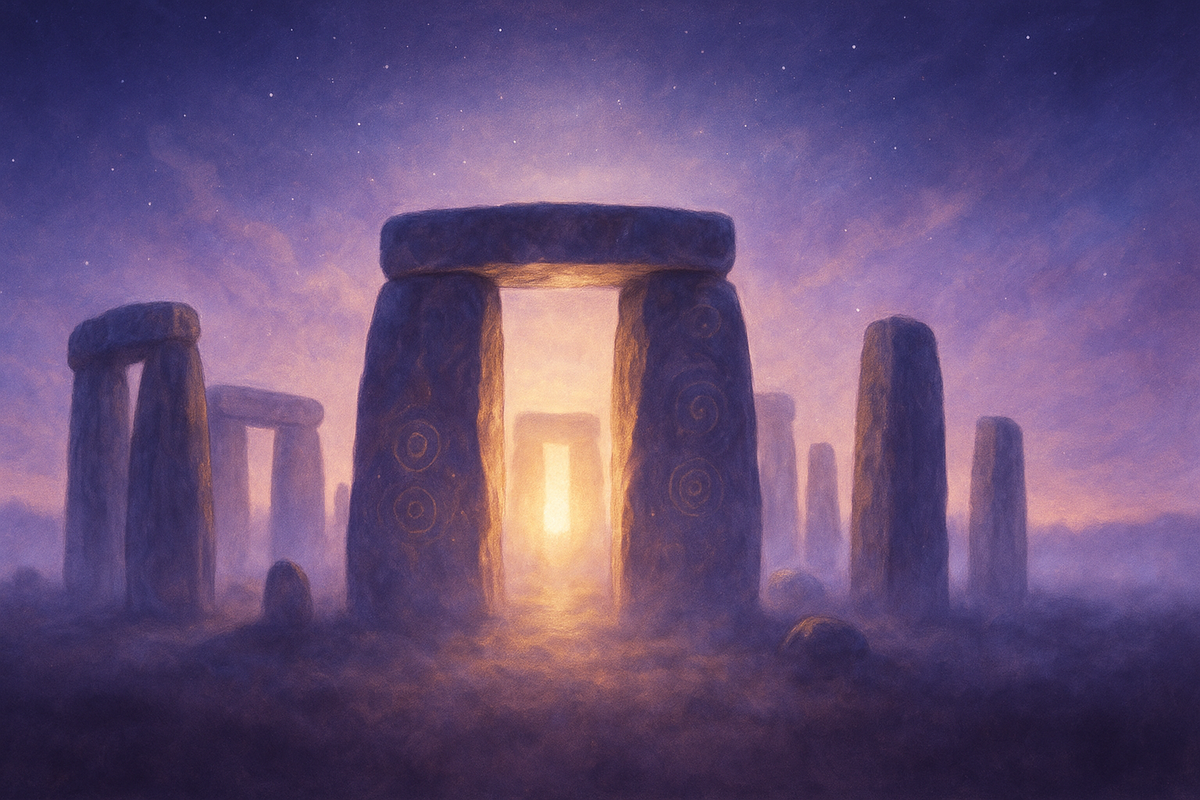Stonehenge: The Solstice Gate and the Singing Stones
Explore the mysteries of Stonehenge, from its solar alignments and acoustic properties to its spiritual significance and ancient rituals.

Stonehenge is more than just a prehistoric monument - it’s a marvel of ancient engineering, astronomy, and acoustics. Here’s what makes it extraordinary:
- Solar Alignment: Stonehenge aligns perfectly with the summer and winter solstices, functioning as an ancient calendar and marking key celestial events.
- Acoustic Design: The unique bluestones produce musical tones when struck, and the stone circle amplifies sound, enhancing ceremonies and rituals.
- Energy Hub: Positioned at the intersection of 14 ley lines, Stonehenge is believed to be a spiritual and energetic focal point.
- Sacred Purpose: Archeological evidence suggests it was used for rituals, with cremated remains of 150 individuals found on-site.
Whether it’s the alignment with the cosmos, the "singing" stones, or its spiritual significance, Stonehenge continues to captivate visitors and researchers alike. Let’s explore how these elements combine to create one of the world’s most mysterious and awe-inspiring sites.
Solstice Alignments at Stonehenge
Solar Calendar Design
The builders of Stonehenge incorporated precise solar alignments into its design, creating what appears to be an ancient solar calendar.
A ring of 30 upright sarsen stones is thought to represent a 360-day year, with additional structures accounting for the extra days and a set of four stones marking leap years.
Dr. Susan Greaney, Senior Properties Historian at English Heritage, highlights this intentional design:
"Stonehenge was carefully designed to align with the movements of the sun."
On the summer solstice, the sun rises directly behind the Heel Stone, casting its light into the center of the monument. The stones framing this solstice axis were meticulously shaped, with their surfaces crafted to form precise vertical edges.
This sophisticated calendrical arrangement not only underscores the site's function as a timekeeping tool but also suggests deeper spiritual interpretations tied to the sun's movements.
Dimensional Gateway Theory
Stonehenge's alignments may go beyond marking time, hinting at a more profound energetic purpose. The site is situated at the convergence of 14 ley lines, positioning it as a powerful energetic hub.
This design, which aligns with celestial events, reinforces the idea that Stonehenge served as more than a calendar - it may have been a bridge between earthly and cosmic realms.
Marc White, a researcher specializing in ancient sites, shares his insights:
"The arrangement of the stones corresponds with significant celestial events, such as the solstices and equinoxes, suggesting that Stonehenge served as an ancient observatory or calendar. Some researchers speculate that this precise alignment may have been intended to mark the location of a cosmic portal - a gateway through which travellers could traverse vast distances in the blink of an eye."
This spiritual significance continues to resonate today. Membership in the British Druid Order has surged in the past decade, growing from 3,000 to 7,000 members.
During solstice periods, Stonehenge is believed to reach a peak in its energetic activity. Practitioners describe a "gateway period" spanning 5–7 days before and after the solstice, a time when spiritual practices become particularly intense.
Archaeological discoveries support this ceremonial importance - cremated remains of approximately 150 individuals were interred during an earlier phase of Stonehenge's history. Interestingly, the site itself shows minimal signs of daily life, further emphasizing its role as a sacred space.
Stonehenge's Ancient Solstice Ritual
Sound Properties of Stonehenge
Beyond its well-known celestial alignments, Stonehenge’s acoustics add another layer to its mystique, potentially playing a key role in its ritual significance.
Bluestone Sound Effects
The bluestones of Stonehenge, sourced from the Preseli Hills in Pembrokeshire - over 150 miles away - have intrigued researchers due to their unique acoustic properties. When struck, these stones produce distinct musical tones, a characteristic that may have influenced their selection for the monument.
Paul Devereux, Principal Investigator of the Landscape and Perception Project, conducted studies along the Carn Menyn ridge, where these bluestones originated. He noted:
"The percentage of the rocks on the Carn Menyn ridge are ringing rocks, they ring just like a bell...And there's lots of different tones, you could play a tune. In fact, we have had percussionists who have played proper percussion pieces off the rocks."
This discovery has prompted speculation that the acoustic properties of the bluestones were a deliberate factor in their transportation to Stonehenge. Professor Tim Darvill commented on this possibility:
"We don't know of course that they moved them because they rang but ringing rocks are a prominent part of many cultures...You can almost see them as a pre-historic glockenspiel, if you like and you could knock them and hear these tunes. And soundscapes of pre-history are something we're really just beginning to explore."
These sonic qualities open the door to exploring how sound might have been integral to ancient rituals at Stonehenge.
Sound Frequencies and Ritual States
Stonehenge’s design creates an acoustic environment that likely enhanced the sensory impact of ancient ceremonies. Research led by Professor Trevor Cox at the University of Salford found that the monument amplifies speech by about 4 decibels for those inside the stone circle.
As Cox explains:
"We know that music is improved by reverberation, so we would imagine if music was played, it would just sound a little bit more powerful and impactful within the circle."
Additionally, the structure’s resonant frequency - around 10Hz - aligns with alpha brain waves, which are associated with meditative states. This suggests that the monument’s acoustic properties could have been intentionally used to heighten ritual experiences.
Key acoustic features of Stonehenge include:
| Feature | Measurement | Effect |
|---|---|---|
| Voice Amplification | +4 decibels | 100% sentence comprehension inside circle |
| Reverberation Time | 0.64 ± 0.03 seconds | Enhanced musical experiences |
| Resonant Frequency | ~10Hz | Linked to meditative brain activity |
Professor Cox highlights how these acoustics create a unique ceremonial space:
"The research definitely gives more information about how Stonehenge might be used. Even if you turn away, there's always stone reflections to reinforce your voice, so it doesn't really matter if you can't see the person talking. It would be quite good for speech communication."
As individuals moved within the stone circle, they would experience distinct acoustic zones, which may have been used to define specific areas for different rituals. While these sound effects undoubtedly enriched ceremonies, some experts argue that acoustics were likely a secondary consideration in the monument’s overall design.
Energy Lines and Sacred Design
Stonehenge’s location is no accident - it taps into converging energy pathways, amplifying its spiritual and energetic significance.
Michael Ley Line Intersection
Stonehenge sits at the crossroads of several ley lines, including the renowned St. Michael line. This pathway stretches from Ireland to Israel and aligns with the spring festival on May 8.
Alfred Watkins, who introduced the term "ley line" in 1921, noted that ancient stone circles and significant landmarks often align along these invisible tracks. Adding to this, modern magnetic studies reveal even more about the site’s unique properties.
Magnetic Field Patterns
Scientific research highlights magnetic anomalies near Stonehenge that may explain some of the phenomena associated with the site.
For example, engineer David Webb identified a 7–10 Hz frequency field near Avebury Henge, a resonance close to the Earth’s Schumann Resonance, which is often linked to feelings of well-being.
Here’s a brief overview of these energetic factors:
| Feature | Effect | Measurement |
|---|---|---|
| Ley Line Convergence | Energy Amplification | Up to 14 ley lines intersecting |
| Magnetic Field | Frequency Alignment | 7–10 Hz resonance |
| Negative Air Ions | Enhanced Well-being | Increased concentration at energy points |
John R. Clarke’s research dives deeper into the significance of Stonehenge’s circular layout:
"When objects are arranged in specific geometric patterns - such as Stonehenge's circular layout - they can influence how particles interact, including aligning or spinning energy within the structure."
Underground water sources near Stonehenge may also play a role in amplifying the site’s energy, grounding and enhancing its network of forces.
The monument’s geometry, the crystalline nature of its stones, and its position at ley line intersections create a unique energetic environment that continues to captivate both researchers and spiritual enthusiasts.
Stonehenge’s alignment with the midsummer and midwinter sun positions underscores the precision of its placement. The interplay between ley lines, magnetic fields, and celestial alignments paints a picture of a site designed not just for ritual but as a powerful energy amplifier.
Visitor Guide to Stonehenge
Plan your visit to Stonehenge and immerse yourself in its timeless energy. This guide is designed to help you connect with the site's ancient atmosphere and celestial alignment, turning your trip into a meaningful experience.
Best Times to Visit
Stonehenge truly comes alive during key astronomical events. For example, the winter solstice, occurring around 8:04 AM, is a particularly special time to feel the site's unique resonance.
Other notable dates include the summer solstice on June 21, as well as the spring and fall equinoxes on March 21 and September 21, respectively. To fully experience the magic of Stonehenge, consider visiting in the early morning to witness the sunrise.
Ways to Connect
Make the most of your visit by incorporating these mindful practices:
- Prepare Yourself: Spend a few moments in quiet reflection before you arrive, setting clear intentions for your visit.
- Engage On-Site: Participate in a sunrise ceremony or join a guided tour to deepen your understanding of the site's energy and history.
- Offer Respect: Consider leaving a small, thoughtful offering like flowers or a crystal as a gesture of gratitude. Many visitors report that simply being present and open can lead to profound moments of insight and connection.
Conclusion
Stonehenge stands as a remarkable testament to the connection between celestial phenomena and earthly energies. Its precise solar alignments reveal an advanced understanding of the cosmos, while its spiritual significance has always been central to its purpose.
As English Heritage explains:
"Spirituality was at the heart of Stonehenge from the start... despite the fact that it serves no known practical function".
The site's unique acoustic properties suggest it may have been used as a "sonic temple" for rituals and ceremonies, though modern visitors might find the experience affected by nearby road noise.
Additionally, the intersection of ley lines at Stonehenge is believed to amplify its spiritual resonance, making it a focal point for contemporary spiritual practices.
Bringing together these elements, Stonehenge continues to captivate and inspire.
Whether you're drawn to its astronomical precision, curious about its acoustic qualities, or seeking a deeper connection to Earth's energy, the site offers a profound sense of timelessness. For thousands of years, it has served as a bridge between ancient knowledge and the spiritual pursuits of the present day.
FAQs
How does Stonehenge's solar alignment work, and what does it tell us about its ancient builders?
Stonehenge’s alignment with the sun during the summer and winter solstices is nothing short of extraordinary. This ancient structure was carefully designed to track the sun’s movements, acting as a calendar that marked key agricultural and ceremonial dates for its builders.
What’s even more impressive is the level of astronomical knowledge required to achieve such precision. The creators of Stonehenge were able to observe and predict the sun's movements with remarkable accuracy, suggesting that the site wasn’t just a place of spiritual significance - it was also a practical tool for managing time.
For Neolithic societies, deeply tied to the rhythms of the seasons, this would have been essential. Some theories even propose that Stonehenge’s design included ways to account for slight variations over time, showcasing the remarkable ingenuity of its builders.
How do the unique sounds of Stonehenge's bluestones enhance rituals and ceremonies?
The bluestones at Stonehenge are thought to possess unusual acoustic qualities, amplifying sound and creating an echo-like effect within the stone circle.
These properties may have been deliberately utilized during rituals and ceremonies, allowing music, chants, or spoken words to resonate powerfully, creating a deeply immersive and spiritual atmosphere.
Some experts propose that this sound-carrying ability wasn’t accidental but rather a purposeful design element. It might have been intended to deepen the sense of connection and awareness among participants during sacred events.
This intriguing auditory feature adds yet another layer of enigma to Stonehenge, suggesting its ancient builders had a remarkable grasp of sound dynamics.
What role do ley lines and magnetic fields play in the spiritual energy of Stonehenge?
Stonehenge is often associated with ley lines and magnetic fields, both of which are thought to contribute to its spiritual energy. Ley lines are believed to be unseen energy pathways connecting sacred sites across the globe, and Stonehenge is considered a major hub where up to 14 of these lines converge.
Many visitors to the site report feeling a surge of energy, a profound sense of connection, or even a healing effect during their time there.
The area around Stonehenge is also tied to distinctive magnetic fields, which some suggest amplify the site's energetic qualities. The stones themselves may play a role in enhancing these effects, with their sonic vibrations potentially intensifying the spiritual experience.
These combined elements create an atmosphere that many describe as mystical and deeply moving, offering a unique opportunity to tap into ancient energies and feel in sync with the Earth's natural rhythms.




